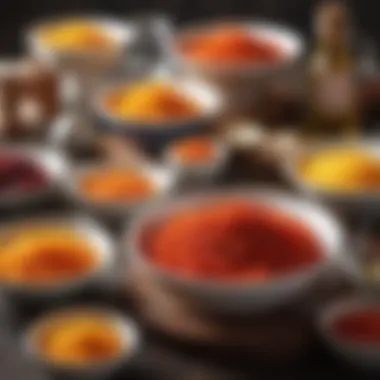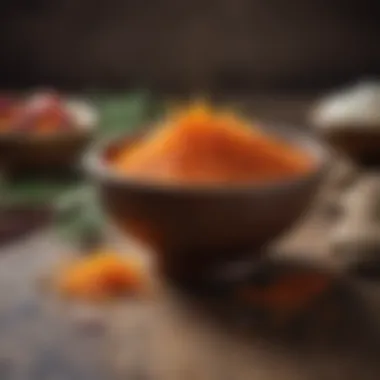Exploring Saffron: Culinary, Medicinal, and Cultural Uses


Intro
Saffron, the crimson thread harvested from the flower of Crocus sativus, stands out not only for its rarity but also for its remarkable versatility. This distinctive spice has permeated various cultures, reflecting its profound historical significance and modern relevance. Saffron is often celebrated for its unparalleled ability to elevate flavors and its attractive color in numerous dishes. However, its uses extend far beyond the kitchen, delving into realms of traditional medicine and contemporary therapeutic practices.
In this article, we will explore several key dimensions of saffron’s utility. From culinary delights to medicinal properties, we will unpack the ways saffron can enrich both diet and health. Moreover, we will address how cultural significance shapes its use, as well as touch on optimal methods for preservation and economic aspects of saffron production.
Understanding saffron's multifaceted nature can enhance our appreciation of this spice, offering insights beneficial to food lovers and health-conscious individuals alike. Through this exploration, we aim to provide a comprehensive guide, inviting readers to discover and integrate saffron into their culinary and health practices.
Prelude to Saffron
Saffron, known for its distinctive color and flavor, holds a unique place in the culinary and medicinal worlds. Understanding saffron's origin and significance can greatly enhance one's appreciation for it. This section will explore its definition, historical context, and cultural impact. Recognizing these elements is crucial for anyone aiming to integrate saffron into their cooking or wellness routines.
Definition and Origin
Saffron is derived from the flowers of Crocus sativus, commonly called the saffron crocus. The vivid stigma of this flower is harvested and processed to create saffron spice. This process is labor-intensive, which contributes to its high value, often labeled as the most expensive spice by weight. Originating from the Mediterranean region, saffron has cultivated a reputation across various cultures over generations. From ancient Greece to Persia and India, its cultivation and trade have shaped economies and cuisines.
Historical Significance
The historical significance of saffron is profound. As early as 1000 B.C., records show that saffron was being used not only as a flavoring agent but also in rituals and medicine. In ancient Egypt, it was used for its health benefits and as an ingredient in perfumes. Roman emperors appreciated saffron's value, often using it in lavish banquets.
In the Middle Ages, it became a symbol of wealth in Europe and was even a subject of trade wars among nations. Today, saffron still carries cultural importance, linked to festivals and traditional dishes in various countries. Its complex history highlights saffron's role as a commodity that transcends mere gastronomy.
Culinary Applications of Saffron
Saffron's culinary applications are vital, showing its versatility and enhancing many dishes. This spice, known for its unique flavor and rich color, not only elevates the taste of food but also offers visual appeal. Understanding its applications helps in appreciating its role in diverse cuisines from around the world. The elevated status of saffron, often documented in cookbooks and restaurant menus, reflects its importance in gourmet cooking.
Flavor Enhancement
Saffron contributes a delicate and complex flavor to dishes. It provides a unique taste that is hard to replicate with other spices. The addition of saffron can transform simple recipes into gourmet meals, making every bite more fragrant and memorable. The careful infusion of saffron into dishes allows chefs to bring out subtle notes in the ingredients. A pinch can go a long way, illustrating the potency of this spice.
Coloring Agent
In addition to flavor, saffron is renowned for its coloring properties. It imparts a vivid golden hue, visually enriching dishes. This characteristic is especially significant in culinary practices where presentation matters. The bright color enhances the overall appeal of meals, making them more inviting. Chefs often rely on saffron to achieve that signature look in their dishes, establishing it as a kitchen staple.
Traditional Dishes Featuring Saffron
Paella
Paella is a standout dish that showcases saffron's culinary prowess. Originating from Spain, this rice dish is defined by its combination of saffron with various proteins and vegetables. The unique characteristic of paella is its vibrant colors and rich flavors, thanks to the infusion of saffron. It is a beneficial choice for this article since it holds cultural significance and exemplifies how saffron enhances traditional meals. The use of saffron in paella provides depth to the dish, allowing it to stand out among other rice recipes.
Risotto alla Milanese


Risotto alla Milanese is another dish that highlights saffron's role in Italian cuisine. The creamy texture of the risotto paired with the luxurious infusion of saffron creates a rich culinary experience. This dish is a beneficial choice for food lovers, illustrating how simply adding saffron can elevate a familiar recipe into something extraordinary. The golden color and warm flavor make it appealing, combining comfort and gourmet dining.
Saffron Biryani
Saffron biryani represents saffron's prominence in Indian cooking. This aromatic rice dish integrates spices, meat, and saffron, providing a complex flavor profile. The distinct aspect of saffron biryani is its layering of flavors, each bringing something special to the overall experience. It is a popular choice, showcasing how saffron can be included in rich, spicy dishes. The addition of saffron enhances both flavor and aroma, making it a noteworthy mention in discussions about saffron's culinary uses.
Medicinal Uses of Saffron
The medicinal uses of saffron are noteworthy, given the rising interest in natural remedies and alternative medicine. This section aims to explore various dimensions of saffron's health benefits. Understanding its traditional uses, as well as scientific findings, provides insight into the spice's valuable contributions to health. Saffron's rich profile contains various bioactive compounds that have attracted attention in both traditional and modern medicinal contexts.
Traditional Medicine Practices
Saffron has long been utilized in traditional medicine across different cultures. In ancient Ayurveda, saffron was viewed as a potent remedy for a host of ailments. Practitioners would use the spice to enhance digestion and alleviate respiratory issues. Furthermore, in Unani medicine, saffron was prescribed for its warming properties and was often blended with other herbs to promote overall wellness. Across many regions such as Europe and the Middle East, saffron was valued not just for its culinary uses but also for its perceived health benefits. The historical application of this spice lays the groundwork for contemporary research into its medicinal properties.
Scientific Research Findings
Recent scientific investigations into saffron have corroborated many of the claims made in traditional medicine. Numerous studies have examined its components, particularly crocin and safranal. These compounds are acknowledged for their potential antioxidant and anti-inflammatory properties. Clinical trials also suggest saffron may help in managing symptoms of depression and anxiety. The depth of the research underscores saffron's multifaceted role in health and supports its inclusion in modern therapeutic practices. This body of scientific literature adds credibility to saffron's age-old reputation as a healer.
Health Benefits of Saffron
Saffron's health benefits merit careful consideration. It possesses unique properties that impact mental and physical health positively.
Mood Enhancement
Saffron has emerged as a notable tranquilizer. Studies indicate it can elevate mood and alleviate symptoms of depression. It appears to influence serotonin levels in the brain, acting as a natural antidepressant. The key characteristic of saffron in this context is its efficacy without the side effects commonly associated with synthetic drugs. This makes it an appealing option for those seeking a safer alternative. However, limited dosage and consistent use are advised to maximize its mood-enhancing potential.
Antioxidant Properties
Saffron is rich in antioxidants, making it a powerful ally against oxidative stress. Antioxidants play vital roles in neutralizing free radicals in the body, potentially lowering the risk of chronic diseases. This characteristic is crucial for anyone looking to improve overall health. While saffron is not a substitute for conventional treatments, it offers unique benefits that can complement a balanced diet. Many individuals find incorporating saffron into their routines enhances their overall well-being, even if these effects are subtle.
Anti-inflammatory Effects
The anti-inflammatory properties of saffron are significant. Compounds in the spice may help reduce inflammation markers in the body. This can lead to alleviation of certain conditions, like arthritis or heart diseases. The unique feature of saffron's anti-inflammatory effects lies in its natural origin; this may provide a more balanced approach to managing inflammation than some pharmaceutical options. Patients often discuss the benefits of integrating saffron into their diets, highlighting its ability to contribute to reduced inflammation over time.
Overall, saffron stands out for its multifaceted health benefits. Its role in mood enhancement, antioxidant defense, and inflammation control enhances its value as a medicinal spice.
In summary, the medicinal uses of saffron echo through both historical and scientific narratives. This comprehensiveness reinforces its standing as an essential part of both traditional and modern health practices.
Cultural Importance of Saffron
Saffron holds a significant place in various cultures around the globe. Its usage extends beyond the culinary arts, deeply interwoven with historical, spiritual, and social practices. Understanding the cultural importance of saffron enhances appreciation for this unique spice and its multifaceted applications.


Saffron is often associated with luxury and wealth due to its high price and labor-intensive harvesting process. This perception elevates its status in cultural rituals, accentuating its role as a symbol of prosperity. In many regions, saffron is a staple in festivals and special occasions, where it signifies both celebration and tradition.
Cultural Rituals and Festivals
Saffron plays a central role in various cultural rituals and festivals across regions. For instance, in India, saffron is commonly used during weddings and religious ceremonies, embodying purity and auspiciousness. It is often included in dishes prepared for guests, symbolizing hospitality and generosity.
In Persian culture, saffron has been used for centuries in Nowruz, the Persian New Year. Families prepare dishes enhanced with saffron to mark the arrival of spring, symbolizing renewal and growth. Notably, saffron is also a key ingredient in traditional Persian sweets served during celebrations.
Moreover, saffron festivals celebrate its harvest and culinary significance. The Crocus sativus plant, which produces saffron, becomes the focus of events in regions where it is cultivated. These festivals not only honor the spice but also educate attendees about the history and the labor-intensive farming practices involved in saffron production.
Regional Variations in Usage
Different regions exhibit unique traditions and uses of saffron, influenced by local customs, cuisine, and agriculture. In Southern Spain, saffron is crucial to the iconic dish paella, which has become synonymous with Spanish gastronomy. The use of saffron in this dish showcases its ability to not only enhance flavor but also impart a vibrant color.
In India, saffron is integral to making dishes like biryani, where its infusion elevates both scent and flavor. Similarly, in Italy, saffron is essential in risotto alla Milanese, highlighting its versatility across cuisines.
The regional uses of saffron reflect not just culinary artistry but also cultural identity. Local adaptations of saffron highlight its significance in nurturing traditions while simultaneously allowing for innovation in food preparation.
"Saffron is more than a spice; it is a thread that binds peoples and cultures through shared culinary and social experiences."
Overall, the cultural importance of saffron transcends mere culinary applications. It is entrenched in rituals, celebrations, and local identities, making it a spice worthy of recognition and exploration.
Practical Considerations for Using Saffron
Saffron’s unique qualities necessitate careful handling for optimal results. Whether you are a seasoned chef or a curious beginner, understanding how to use saffron properly is key to unlocking its full potential. This section addresses the importance of adhering to specific guidelines, maximizing flavor and aroma in your dishes while preserving the delicate threads.
Optimal Usage Guidelines
Saffron is an investment, and using it correctly can enhance your culinary creations significantly. Here are essential guidelines:
- Amount: Generally, a pinch of saffron is enough for most recipes. Using too much can lead to a bitter flavor, overshadowing the intended taste of the dish.
- Preparation: Soak saffron threads in warm water, broth, or milk before adding them to your cooking. This process not only helps to release the color and flavor but also ensures even distribution throughout the dish.
- Timing: Add saffron at the right moment. Incorporating it too early might diminish its flavor profile, while adding it too late may not allow enough time for the full flavor to develop.
- Temperature: Saffron thrives in warm environments. Cooking at a low simmer rather than a rapid boil preserves its delicate taste and aroma.
"Saffron should be used judiciously to fully appreciate its unique characteristics. Proper handling is crucial."
These guidelines help in enhancing the saffron experience, ensuring that its culinary magic is fully realized.
Storage and Preservation
The delicate nature of saffron threads makes their storage and preservation vital. Ensuring you maintain its quality requires attention to the following aspects:
- Air-tight Container: Store saffron in a sealed glass jar or an air-tight container to protect it from moisture and air.
- Cool, Dark Location: Keep saffron away from light and heat. A cool, dark pantry is often ideal for preserving its potency.
- Avoid Long Duration: Although saffron can last for years if stored properly, it is best used within the first two to three years of purchase for optimal flavor and color.
- Check for Freshness: When using saffron, smell and look for vivid color. Dullness or lack of aroma indicates that saffron may have lost its character.


Following these storage practices can keep saffron fresh, ensuring it remains a valuable asset in your culinary endeavors. Proper handling amplifies its unique essence, giving you not only better dishes but also enhancing your enjoyment of this exquisite spice.
Economic Aspects of Saffron
The economic aspect of saffron shines a light on its significant impact not only on local economies but also on global markets. As one of the most expensive spices in the world, saffron's pricing reflects its rarity and labor-intensive harvesting process. This section explores various factors affecting saffron pricing, the main production regions, and the economic implications tied to its cultivation.
Pricing Dynamics
Saffron pricing is complex. It varies based on quality, cultivation methods, and market demand. High-quality saffron can reach exorbitant prices, often exceeding 2,000 USD per kilogram. Factors influencing these prices include:
- Seasonality: Saffron is harvested only once a year, which creates scarcity and drives up demand during off-seasons.
- Quality Standards: The grading of saffron strands affects their value. Higher grades with stronger color, aroma, and flavor correspond to higher prices.
- Market Fluctuations: Global demand continues to rise, influenced by culinary trends and health awareness. Increased interest raises competition, impacting prices.
Overall, understanding these dynamics helps buyers make informed decisions.
Global Production Areas
Global saffron production is concentrated in a few key areas, each offering distinct characteristics that contribute to the spice's reputation and market value.
Iran
Iran is the largest producer of saffron, accounting for around 90% of the world's supply. The unique climatic conditions, particularly in regions like Khorasan, are beneficial for saffron cultivation. The country prides itself on producing high-quality saffron, which is often renowned for its deep flavor and vibrant color. One distinct feature of Iranian saffron is its rich aroma, which many chefs and culinary experts prefer. However, political sanctions and trade restrictions can sometimes hinder its market reach.
India
India, particularly the Kashmir region, is known for its traditional saffron cultivation. Indian saffron is characterized by its robust flavor and deep red color. The unique harvesting technique passed down through generations adds to its cultural significance and authenticity. This historical connection makes Indian saffron especially appealing to consumers looking for quality and heritage. However, challenges such as climate change and geopolitical issues can impact production levels and pricing.
Greece
Greece is a smaller player in the saffron market but is noteworthy for producing high-quality strands, especially in the region of Macedonia. Greek saffron is recognized for its distinct flavor and bright color, making it a desirable option for many culinary applications. Its cultivation often uses organic practices, appealing to health-conscious consumers. However, Greece's production volume is limited compared to Iran and India, which can influence its pricing and availability in global markets.
"Saffron’s value is not just in its price, but in its cultural significance and the stories of the regions where it is produced."
In summary, the economic aspects of saffron intertwine with global trade dynamics, cultural heritage, and regional differences in production methods. Each production area adds its own unique flair to the market while contributing to the complexity of saffron pricing.
Ending
The conclusion serves as a vital summarization of the various facets explored in this article regarding saffron. This spice is not just a simple culinary ingredient; it is a complex entity with historical, medicinal, and cultural dimensions. Understanding its diverse applications enhances appreciation for saffron, notably elevating its status in kitchens globally.
The Role of Saffron in Modern Culinary Arts
Saffron's presence in contemporary culinary arts is prominent. It is celebrated for its ability to enhance both flavor and visual appeal. Chefs around the world incorporate saffron into a range of dishes, from traditional recipes to avant-garde cuisine. This versatility is perhaps its most striking feature. Dishes such as Risotto alla Milanese exemplify this blend of tradition and innovation, utilizing saffron not just to create flavor depth, but also to impart a rich golden hue.
Moreover, saffron's unique profile often invites experimentation. Bartenders incorporate saffron into cocktails, showcasing its aromatic qualities. Innovative chefs integrate saffron into sauces and marinades, demonstrating its flexibility. This adaptability has enabled saffron to transcend cultural boundaries, making it a desirable ingredient in fusion cuisine.
Future Perspectives on Saffron Usage
As we look towards the future, saffron's role is poised to evolve even further. Emerging research consistently highlights its potential health benefits, ranging from mood enhancement to antioxidant properties. This growing body of scientific evidence could lead to increased popularity in both culinary and medicinal applications.
Moreover, sustainability is becoming an essential consideration in saffron production. With rising concerns about environmental impacts, there may be shifts towards organic cultivation practices. As awareness increases, consumers might demand ethically sourced saffron, fostering a market for sustainable practices.







